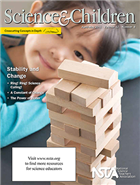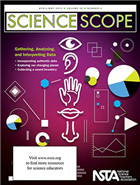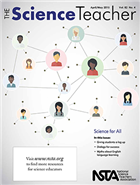Science for all
By Mary Bigelow
Posted on 2015-05-30

The most recent NSTA K-12 journals have suggestions, lesson ideas, and resources for helping all students engage with the disciplinary content, crosscutting concepts, and science and engineering practices that make up the NGSS.
Science & Children — Stability and Change
Although this may sound like an oxymoron (“the more things change, the more they stay the same?”), this is actually one of the NGSS crosscutting concepts. It’s one that would be appropriate for many topics in the general sciences: Newton’s Laws, equilibrium, food webs, body systems, weather and climate, plate tectonics, other systems studies.
Here are some SciLinks with weblinks for content information and suggestions for additional activities and investigations related to this month’s featured articles:
- Ring! Ring! Science Calling! [SciLinks: Genetics]
- A Constant of Change [SciLinks: Sun]
- What Happens When An Environment Changes? [SciLinks: Food Chains
- The Power of Water [SciLinks: Water Erosion, Severe Storms]
- Teaching Through Trade Books: The Earth’s Changing Surface [SciLinks: Dynamic Earth, Water Erosion, Earthquakes, What processes change landforms?]
- Formative Assessment Probes: No More Plants [SciLinks: Ecosystems, Food Chains and Food Webs]
- Methods and Strategies: Garden-Based Learning: It’s Just the Berries! [SciLinks: Factors Affecting Plant Growth]
- Science 101: How Does Stable Equilibrium Differ From Other Kinds of Equilibrium? [SciLinks:
- The Early Years: Recognizing Stability and Change [SciLinks: What Are Systems?]
 Science Scope — Gathering, Analyzing, and Interpreting Data
Science Scope — Gathering, Analyzing, and Interpreting Data
The lessons described here (many of which illustrate the 5E model), illustrate the integration of NGSS disciplinary core ideas and crosscutting concepts with science and engineering concepts related to the collection, analysis, interpretation, and communication of data. The articles feature traditional methods as well as technology software and apps.
Here are some SciLinks with weblinks for content information and suggestions for additional activities and investigations related to this month’s featured articles:
- Using the Scientific Process to Engage Students With Our Changing Planet [SciLinks: Changes in Climate, Changes in Ecosystems, Biotic and Abiotic Factors, Ecosystems]
- Exploring Sound! Using Tablets in Middle School Science [SciLinks: Properties of Sound, Sound Quality]
- Using Authentic Data to Enhance Middle School Atmospheric Science Instruction [SciLinks: Tornadoes, Severe Weather, Storms]
- “Nor Any Drop to Drink” Students Engineer Solutions for Desalinating Ocean Water [SciLinks: Desalination, Water Quality]
- Teaching With Tarantulas [SciLinks: Arachnida]
- Let Them Eat Cake …OE-Cake! [SciLinks: Phase of Matter, Density]
- Tried and True: The Science of Bending Light [SciLinks: Refraction, Properties of Light]
 The Science Teacher — Science for All
The Science Teacher — Science for All
As the editor notes, “More often than not, high-quality teaching strategies like those in this issue benefit students well beyond the targeted group.” There are many suggestions for including all students in learning science, including special needs students and English language learners.
Here are some SciLinks with weblinks for content information and suggestions for additional activities and investigations related to one of this month’s featured articles:
- Making Molecular Movies [SciLinks: Polymers]
Disclaimer: The views expressed in this blog post are those of the author(s) and do not necessarily reflect the official position of the National Science Teaching Association (NSTA).


